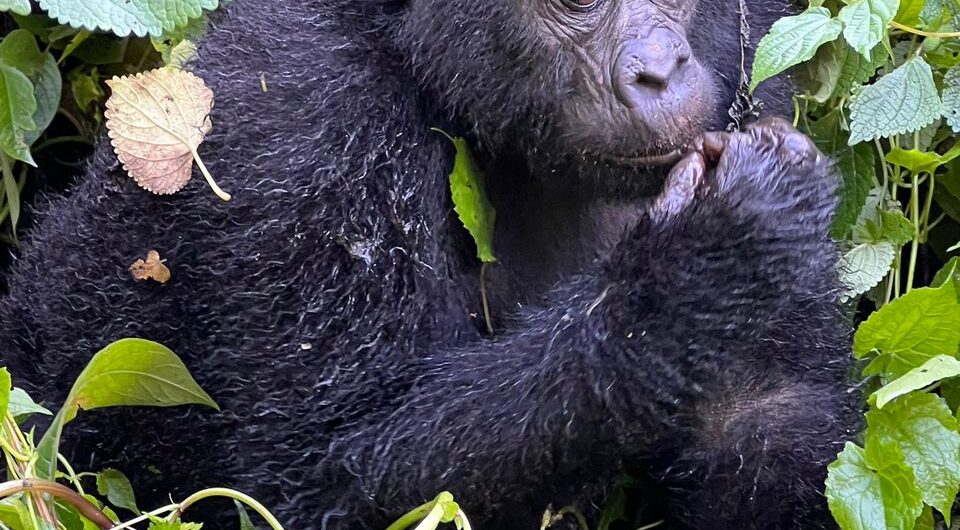Trekking with gorillas is an incredible and once-in-a-lifetime adventure. It is an extraordinary and life-changing experience to see mountain gorillas in their own environment. There will inevitably be questions, as there always are on any big adventure. To help you be ready, we have compiled a list of some of the most often asked questions (FAQs) about mountain gorilla trekking.
- What is Gorilla Trekking?
The term “gorilla trekking” describes the adventure of venturing into the woods in search of mountain gorillas. Because mountain gorillas are endemic to only three countries—Uganda, Rwanda, and the DRC—the events usually center on these three countries.
Follow seasoned guides as they lead trekkers through verdant jungles in search of a family of mountain gorillas. Depending on the whereabouts of the gorillas on any given day, the duration of the trip could range from thirty minutes to eight hours.
- Where Can I See Mountain Gorillas?
Mountain gorillas can only be seen in three countries.
Uganda: Bwindi Impenetrable National Park and Mgahinga Gorilla National Park.
Rwanda: Volcanoes National Park.
DRC: Virunga National Park.
Uganda and Rwanda are the most popular destinations for gorilla trekking, with Uganda being slightly more affordable.
- How Much Does a Gorilla Trekking Permit Cost?
The cost of gorilla trekking permits varies by country.
Uganda: $800 USD for foreign non-residents, $700 USD for foreign residents, and UGX 300,000 for East African citizens.
Rwanda: $1,500 USD for all trekkers.
DRC: Around $450 USD, but this can vary.
Permits are required and are limited to a small number of trekkers per day to protect the gorillas and their environment. It’s important to book your permit months in advance, especially during the peak season.
- What Is the Best Time to Go Gorilla Trekking?
The best time to go gorilla trekking is during the dry seasons, which are,
December to February
June to September
During these months, the weather is more favorable, with less rain and drier trails. However, the wet seasons (March to May, October to November) can offer fewer crowds and more affordable travel options, although the trails can be slippery and more challenging.
- How Difficult is the Gorilla Trek?
Factors like as your degree of fitness, the weather, and the whereabouts of the gorillas all influence how challenging the walk will be. The difficulty level of the climb may range from moderate to difficult. In the thick of a jungle, hikers may spend hours trudging over terrain that is steep, uneven, and sometimes muddy.
To get in shape for the hike, it’s suggested to do things like mild cardio, leg exercises, and trekking.
- How Close Can I Get to the Gorillas?
A minimum distance of 7 meters (21 feet) should be maintained by visitors from the gorillas. Keeping our distance from gorillas helps keep both species safe and stops the transmission of sickness.
Never panic or make a frantic lunge toward a gorilla if it approaches you. As you make your way back, your guides may advise you to take it easy.
- Can Children Participate in Gorilla Trekking?
Gorilla trekking requires a minimum age of fifteen years old. This age restriction is put in place to prevent the spread of sickness to the gorillas and to make sure that participants can manage the physical demands of the walk.
- How Long Will I Spend with the Gorillas?
Finding the gorilla family is the first step; you’ll have an hour to watch them. You may observe their behaviors, snap pictures (without flash), and feel the energy of their interactions throughout this hour. In order to keep people from becoming too disruptive, a time restriction has been set.
- What Should I Wear for Gorilla Trekking?
Wearing the right clothing and gear is essential for a successful trek.
Hiking boots: Comfortable, sturdy, and waterproof.
Long-sleeved shirt and long pants: To protect against scratches from vegetation and insect bites.
Rain jacket: Weather in the rainforest can change quickly.
Insect repellent: To ward off mosquitoes and other insects.
Hat and sunscreen: While much of the trek is in the shade, some areas may be exposed.
Gloves: Useful for gripping onto branches and protecting your hands.
- Can I Take Photos of the Gorillas?
You may certainly snap pictures of the gorillas, but you must not use a flash. Flashes may frighten or annoy gorillas. To get sharp shots from 7 meters away, bring a high-quality camera with a zoom lens.
- Are Mountain Gorillas Dangerous?
In most cases, mountain gorillas are calm and easygoing. Because of a process called “habituation,” they get used to being around people and usually act calmly when guests arrive. Nevertheless, it is crucial to adhere to the guidelines provided by your guide in order to maintain a safe and considerate encounter with these wild creatures.
- Can Gorillas Catch Diseases from Humans?
A lot of human illnesses, particularly respiratory infections, may affect mountain gorillas. Keeping your distance, not going if you’re sick, and following all the rules throughout the walk are all very important for this reason. The survival of many gorilla populations is dependent on reducing the spread of illness.
- Is It Ethical to Go Gorilla Trekking?
While acting appropriately, yes. In order to save the gorillas and their natural environment, national parks and wildlife officials impose stringent regulations on gorilla trekking. A considerable amount of the money collected from gorilla permits is used for conservation initiatives, including as fighting poaching, protecting habitat, and building communities. These animals are in grave risk of extinction, but your visit will help keep them safe.
- Can I Combine Gorilla Trekking with Other Activities?
Absolutely! Uganda and Rwanda offer many opportunities to explore more than just gorillas. Some popular activities include.
Chimpanzee tracking in Kibale Forest (Uganda).
Wildlife safaris in Queen Elizabeth National Park (Uganda) or Akagera National Park (Rwanda).
Golden monkey trekking in Mgahinga Gorilla National Park (Uganda).
Cultural tours to visit local communities and learn about the region’s diverse cultures.
- Is Gorilla Trekking Safe?
It is usually safe to go gorilla trekking. Most gorilla parks have strict safety measures in place, and treks are guided by competent and experienced guides. For a worry-free and memorable adventure, be sure you book with a trustworthy tour operator and adhere to all park regulations.

